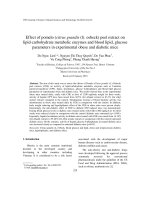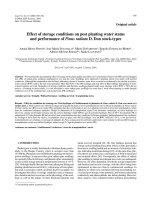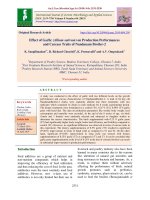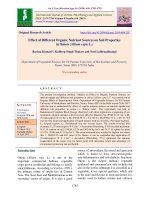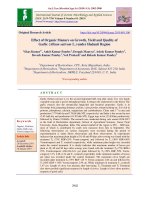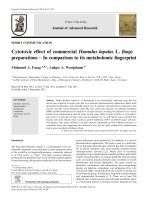Effect of storage conditions on seed longevity of onion (Allium cepa L.)
Bạn đang xem bản rút gọn của tài liệu. Xem và tải ngay bản đầy đủ của tài liệu tại đây (288.83 KB, 9 trang )
Int.J.Curr.Microbiol.App.Sci (2019) 8(2): 1897-1905
International Journal of Current Microbiology and Applied Sciences
ISSN: 2319-7706 Volume 8 Number 02 (2019)
Journal homepage:
Original Research Article
/>
Effect of Storage Conditions on Seed Longevity of Onion (Allium cepa L.)
C. Geetanjali1*, I.M. Sangeeta1, S.M. Prashant1, Basavegowda1 and R.V. Beladhadi2
1
Department of Seed Science and Technology, 2Department of Soil Science, University of
Agricultural Sciences, Raichur-584 104, Karnataka, India
*Corresponding author
ABSTRACT
Keywords
Onion, storage
conditions,
Packaging
materials, Seed
quality,
Commercial cold
storage
Article Info
Accepted:
15 January 2019
Available Online:
10 February 2019
An experiment was conducted to know the effect of storage conditions on
seed quality of onion cv. Arka kalyan. The experiment consisted of three
storage conditions (ambient condition, conditioned cold storage (18-20◦C,
45-50% RH), commercial cold storage (5-7 ͦ C , 65 % RH). The results
revealed that, seeds stored in commercial cold storage (5-7 ͦ C + 65 % RH)
recorded significantly higher seed germination, speed of germination, test
weight, root length, shoot length, seedling dry weight, vigour index, lower
moisture content and electrical conductivity after 10 months of storage.
Hence commercial cold storage was found to be best for maintaining seed
quality parameter.
Introduction
Onion (Allium cepa L.) is one of the
commercially important spice vegetable crops
grown all over the world. It is a member of
Amaryllidaceae
(2n=16
chromosome),
belongs to herbaceous monocot bulbous plant
with annual bulb production and biennial seed
production. Seed is the foundation of
agriculture for enhancing crop production, but
the availability of quality seed is the main
constraint to crop production in developing
country like India. Onion seed production
takes longer time as compared with other bulb
and spice crops. There are many factors
which affect the seed quality and growth
potential attributes of many crops, among
them, use of quality seeds is the most
important one. The quality of the seed is
highest when it completes structural and
functional development on plant itself.
Thereafter, it deteriorates irreparably and
irreversibly at varying rates (Delouche and
Baskin 1973).
1897
Int.J.Curr.Microbiol.App.Sci (2019) 8(2): 1897-1905
Onion is a poor storer and hence seeds losses
its viability very quickly. Onion is an
important vegetable crop and good seed is a
basic input in vegetable production. Its seed
are short lived under ambient conditions
(Doijode, 1987). Since, seed is a living entity
and is subjected to various environmental
stresses which affect the quality. Regular
fluctuation in temperature, moisture content
makes the storage of seeds troublesome
(Suma et al., 2013). Under unfavourable
storage condition such as high temperature
and relative humidity the variation in seed
germination rate can be high (Sisman, 2005).
In storage, the declination of germinability
with high moisture content is related to the
hygroscopic nature of seeds, especially under
worm temperatures, which in turn is
associated with the relative humidity of
surrounding air at ambient condition. After
ten months of storage period, maximum
decrease in all the seed quality parameters
with higher moisture content was noticed in
onion seeds. In this view the present
investigation entitled “effect of storage
conditions on seed longevity of onion (Allium
cepa L.)” was undertaken.
Materials and Methods
The present investigation was carried out in
laboratory of the Department of Seed Science
and Technology, College of Agriculture,
University of Agricultural Science, Raichur.
Fresh seeds of onion variety Arka Kalyan
having initial germination of 95 per cent was
obtained from Agricultural Research Station,
Hagari, Bellary District Karnataka. The
experiment consisted of three storage
conditions viz., C1: Ambient condition C2:
Conditioned cold storage (18-20◦C, 45-50%
RH) and C3: Commercial cold storage (5-7◦C,
65% RH). All the seeds were treated with Carbendazim 2 g/kg and stored for ten
months. The experiment was carried out using
Completely Randomized Design (Factorial)
repeated four times. Seeds were packed in
three different packing materials and stored in
three
different
storage
conditions.
Observations were recorded at monthly
interval on germination (%), speed of
germination, root length (cm), shoot length
(cm), seedling dry weight (mg), seed vigour
index, seed moisture content (%) and
biochemical observation viz., dehydrogenase
activity, alpha amylase enzyme activity and
electrical conductivity were recorded at
bimonthly intervals. Germination test was
carried out using paper towel technique as per
the procedure given by ISTA (1999).
Germinated seeds were counted on 12th day
and 10 germinated seedlings were selected
from each replication of the treatment for
calculating the seedling vigour index. The
seedling vigour index (length and mass) was
calculated by using the formula given by
Abdul-Baki and Anderson, 1973. The shoot
and root length of each of the 10 seedlings
were measured in centimeters. Seedling dry
weight (mg) was measured for all the
germinated seedlings after oven drying.
Electrical conductivity of the seed leachate
was measured in the digital conductivity
bridge (WENSAR) with a cell constant 1.0
and the mean values were expressed in
decisiemens per meter (dSm-1) (Milosevis et
al., 2010). The OD value of dehydrogenase
enzyme activity was obtained as reported by
Kittock and Law, (1968). The α-amylase
enzyme activity was analysed as per the
method suggested by Simpson and Naylor
(1962). The data were statistically analyzed as
per the method of Cochran and Cox (1957)
for
Completely
Randomized
Design
(Factorial).
Results and Discussion
Results of storage conditions on moisture
content of Arka kalyan represented in Table
1. The temperature maintained in commercial
cold storage was 5-7 °C and relative humidity
1898
Int.J.Curr.Microbiol.App.Sci (2019) 8(2): 1897-1905
was 65 per cent. The onion seeds packed in
pervious packaging materials and stored in
commercial cold storage gained moisture
content and this is evidenced by rise in
moisture content from 6.00 to 7.68 per cent at
the end of storage period. This was due to
prevalence of higher RH or vapour pressure
and low temperature in cold storage. The
seeds stored in ambient condition also gained
moisture content and it is evidenced by rise in
moisture content to 7.56 per cent from 6.00
per cent due to prevalence of higher vapour
pressure. The relative humidity under ambient
condition varied from 87 to 62 per cent during
storage period. The vapour pressure in
commercial cold storage was more hence
moisture content in seeds was also more (7.68
%) compared to seeds stored in ambient
condition. These results are in accordance
with findings of Harrington (1960) who has
reported the higher moisture content of seed
controlled by relative humidity and
temperature in the storage environment.
Similar findings were also been recorded by
Devanal et al., (2012) in sunflower and
Basavegowda et al., (2013) in chickpea, Na et
al., (2013) in sesame and Meena et al., (2017)
in cotton and groundnut.
Results of storage conditions on test weight of
Arka kalyan represented in Table 2. Higher
test weight of seeds was noticed in seeds
stored under ambient condition which was
due to the moisture absorbance by the seeds
due to humidity. Lowest test weight of seeds
was noticed in seeds stored in cold condition
which is due lower humidity levels in the
storage conditions. In present experiment, the
highest test weight (3.53 g) was recorded in
ambient condition (C1) which was followed
by conditioned cold storage (C2) (3.52 g) and
lowest was recorded in commercial cold
storage (C3) (3.51 g) after one month of
storage. This was influenced by many
different factors such as seed potential,
humidity and storage condition and seed
quality. At the end of storage period C1
recorded significantly higher test weight (3.08
g) which was on par with C2 (3.07 g) and
significantly lowest was recorded in
commercial cold storage C3 (2.97 g). The
results are in accordance with the earlier
findings of Malcolm et al., (2003) in peach,
Akbari et al., (2004) in soybean and Mashtati
et al., (2008) in wheat.
Germination is the most important function of
a seed as an indicator of its viability and
worth as seed (Table 2 and 3). The results
revealed that after one month of storage,
highest germination and speed of germination
(96.40 % and 34.90 respectively) were
recorded in commercial cold storage (C3)
followed by conditioned cold storage (C2)
(95.75 % and 34.61 respectively) but seeds
stored in ambient condition (C1) recorded
lower germination and speed of germination
(95.02 % and 34.21 respectively). The
increased germination under controlled
condition may be attributed to low
temperature decrease the rate of deterioration
of seeds but it was high under ambient
condition. There was gradual reduction in the
germination percentage from one to ten
months of storage in all the conditions,
however at the end of tenth month of storage,
the seeds stored at commercial cold storage
(C3) recorded germination above minimum
seed certification standards and highest speed
of germination (85.54 % and 25.78
respectively) followed by conditioned cold
storage (C2) (78.91 % and 25.06 respectively)
and significantly lowest values were observed
in ambient condition (C1) (62.12 % and 15.80
respectively). Higher seed quality parameter
in lower temperature might be attributed to
reduced metabolic activity like reduced lipid
peroxidation resulted in enhanced antioxidant
activity which protects seeds from
deterioration. Alhamdan et al., (2011)
reported that seeds of onion stored at 5°C had
the highest seed germination percentage.
1899
Int.J.Curr.Microbiol.App.Sci (2019) 8(2): 1897-1905
Results obtained under the present study are
supported by the findings of Hanna et al.,
(2013) and Demir et al., (2016) in onion.
Results of storage conditions on root length
and shoot length of Arka kalyan represented
in Table 4 and 5. In the present study at the
end of first month of storage period, the
highest root length (7.98 cm) and shoot length
(7.57 cm) were recorded in commercial cold
storage (C3) which was followed by
conditioned cold storage (C2) (7.97 cm and
7.56 cm respectively) whereas, the lowest
values were recorded in ambient condition
(C1) (7.96 cm and 7.55 cm respectively).
Seeds preserved in cold storage recorded
higher root length and shoot length as
compared to ambient condition which may be
due to lower respiration rate and metabolic
activity at lower temperature, hence the
higher seedling length is an indication of
maintenance of vigour in the seeds preserved
in cold storage. At the end of tenth month of
storage period, seed stored at commercial cold
storage (C3) recorded significantly maximum
root length (7.03 cm) and shoot length (6.88
cm) which was followed by conditioned cold
storage (C2) (6.65 cm and 6.42 cm
respectively) and lowest was recorded in
ambient condition (C1) (5.70 cm and 5.30 cm
respectively). Similar findings reported by
Balesevic-Tubic et al., (2010) in oilseed
crops, Khalequzzaman et al., (2012) in
frenchbean, Basavegowda et al., (2013) in
chickpea, Venge et al., (2016) in soybean and
Patel et al., (2017) in onion.
Results of storage conditions on seedling dry
weight of Arka kalyan represented in Table 6.
The highest seedling dry weight was recorded
in commercial cold storage (C3) (22.16 mg)
which was followed by conditioned cold
storage (C2) (22.13 mg) whereas minimum
seedling dry weight was noticed (21.98 mg)
in ambient condition (C1). Reduction in
seedling dry weight might be due to shorter
root and shoot length registered in our study
which had a direct correlation with dry
weight. Following the same trend, the seeds
stored in commercial cold storage (C3)
recorded significantly highest seedling dry
weight (15.01 mg) which was followed by
conditioned cold storage C2 (12.98 mg) and
significantly lowest seedling dry weight was
recorded in ambient condition C1 (10.36 mg).
Similar findings were given by Kandil et al.,
(2013) in soybean, Demir et al., (2016) in
lettuce and Kavitha et al., (2017) in sesame.
Table.1 Effect of storage conditions on moisture content (%) of onion seed during storage
Treatment
C1
C2
C3
Mean
SEm±
CD at 1 %
1
6.99
6.84
6.94
6.92
0.19
NS
2
7.23
6.85
7.04
7.04
0.14
NS
3
7.37
6.86
7.08
7.10
0.06
0.24
Storage period in months
4
5
6
7
7.82 8.11 8.32 8.13
6.90 7.04 7.14 7.22
7.16 7.23 7.32 7.40
7.29 7.46 7.59 7.58
0.06 0.08 0.04 0.08
0.22 0.31 0.15 0.31
8
7.88
7.37
7.48
7.57
0.07
0.28
NS - Non significant; Storage conditions (C); C1 – Ambient storage condition; C2 – Conditioned cold storage
(18-20 °C, 45-50% RH); C3 – Commercial cold storage condition; (5 to 7 °65% RH)
1900
9
7.64
7.53
7.59
7.59
0.04
0.16
10
7.56
7.58
7.68
7.61
0.07
0.27
Int.J.Curr.Microbiol.App.Sci (2019) 8(2): 1897-1905
Table.2 Effect of storage conditions on germination (%) of onion seed during storage
Treatment
C1
C2
C3
Mean
SEm±
CD at 1 %
1
95.02
(77.13)
95.75
(78.11)
96.40
(79.75)
95.72
(78.33)
0.39
NS
2
94.03
(75.86)
94.55
(76.51)
95.58
(78.40)
94.72
(76.92)
0.40
NS
3
91.17
(72.72)
92.66
(74.30)
94.42
(77.10)
92.75
(74.71)
0.36
1.26
4
87.45
(69.27)
90.52
(72.08)
93.46
(75.46)
90.48
(72.27)
0.32
1.12
Storage period in months
5
6
84.52
80.34
(66.89)
(63.76)
89.10
87.47
(70.74)
(69.32)
92.19
90.68
(74.11)
(72.55)
88.60
86.16
(70.58)
(68.55)
0.28
0.20
0.98
0.70
7
75.37
(60.35)
84.65
(66.97)
89.24
(71.23)
83.08
(66.18)
0.24
0.84
8
71.07
(57.57)
82.76
(65.51)
87.89
(70.04)
80.57
(64.37)
0.25
0.87
9
66.85
(54.97)
81.10
(64.32)
86.81
(69.16)
78.25
(62.81)
0.27
0.94
NS - Non significant; Storage conditions (C); C1 – Ambient storage condition; C2 – Conditioned cold storage
(18-20 °C, 45-50% RH); C3 – Commercial cold storage condition; (5 to 7 °65% RH)
Table.3 Effect of storage conditions on speed of germination of onion seed during storage
Treatment
C1
C2
C3
Mean
SEm±
CD at 1 %
1
34.21
34.61
34.90
34.57
0.36
NS
2
33.67
34.07
34.43
34.06
0.31
NS
3
32.10
33.77
34.12
33.33
0.07
0.24
Storage period in months
4
5
6
7
31.27
29.91
28.07
25.01
33.31
32.22
30.77
29.15
33.79
32.84
31.62
30.50
32.79
31.66
30.16
28.22
0.08
0.06
0.06
0.07
0.28
0.21
0.21
0.24
8
21.71
27.95
29.11
26.26
0.08
0.28
9
18.70
26.47
27.60
24.26
0.07
0.24
10
15.80
25.06
25.78
22.21
0.05
0.17
NS - Non significant; Storage conditions (C); C1 – Ambient storage condition; C2 – Conditioned cold storage
(18-20 °C, 45-50% RH); C3 – Commercial cold storage condition; (5 to 7 °65% RH)
Table.4 Effect of storage conditions on root length (cm) of onion seed during storage
Treatment
C1
C2
C3
Mean
SEm±
CD at 1 %
1
7.96
7.97
7.98
7.97
0.068
NS
2
7.92
7.93
7.94
7.93
0.024
NS
3
7.70
7.86
7.87
7.81
0.005
0.017
Storage period in months
4
5
6
7
7.50
7.23
7.02
6.72
7.74
7.63
7.46
7.31
7.79
7.71
7.57
7.49
7.68
7.52
7.35
7.17
0.005
0.007
0.010
0.006
0.017
0.024
0.035
0.021
8
6.36
7.09
7.33
6.93
0.006
0.021
9
6.04
6.87
7.18
6.70
0.007
0.024
10
5.70
6.65
7.03
6.46
0.006
0.020
NS - Non significant; Storage conditions (C); C1 – Ambient storage condition; C2 – Conditioned cold storage
(18-20 °C, 45-50% RH); C3 – Commercial cold storage condition; (5 to 7 °65% RH)
Table.5 Effect of storage conditions on shoot length (cm) of onion seed during storage
Treatment
C1
C2
C3
Mean
SEm±
CD at 1 %
1
7.55
7.56
7.57
7.56
0.017
NS
2
7.54
7.55
7.55
7.54
0.014
NS
3
7.51
7.52
7.54
7.52
0.004
0.014
Storage period in months
4
5
6
7
7.42
7.34
7.16
6.87
7.47
7.41
7.31
7.14
7.50
7.44
7.36
7.26
7.46
7.40
7.27
7.09
0.004
0.011
0.005
0.004
0.014
0.038
0.017
0.014
8
6.40
6.91
7.12
6.81
0.013
0.045
NS - Non significant; Storage conditions (C); C1 – Ambient storage condition; C2 – Conditioned cold storage
(18-20 °C, 45-50% RH); C3 – Commercial cold storage condition; (5 to 7 °65% RH)
1901
9
5.89
6.67
7.00
6.52
0.020
0.070
10
5.30
6.42
6.88
6.20
0.012
0.042
10
62.12
(52.23)
78.91
(62.70)
85.54
(67.83)
75.52
(60.92)
0.29
1.01
Int.J.Curr.Microbiol.App.Sci (2019) 8(2): 1897-1905
Table.6 Effect of storage conditions on seedling dry weight (mg) of onion seed during storage
Treatment
C1
C2
C3
Mean
SEm±
CD at 1 %
1
21.98
22.13
22.16
22.09
0.36
NS
2
21.49
21.62
21.77
21.62
0.41
NS
3
20.99
21.10
21.19
21.09
0.01
0.03
Storage period in months
4
5
6
7
20.47
19.99
19.21
18.02
20.63
20.13
19.25
18.37
20.68
20.17
19.35
18.59
20.59
20.10
19.27
18.32
0.01
0.02
0.02
0.01
0.04
0.06
0.07
0.03
8
16.37
17.00
17.71
17.03
0.02
0.06
9
13.36
14.99
16.37
14.91
0.02
0.07
10
10.36
12.98
15.01
12.78
0.02
0.06
NS - Non significant; Storage conditions (C); C1 – Ambient storage condition; C2 – Conditioned cold storage
(18-20 °C, 45-50% RH); C3 – Commercial cold storage condition; (5 to 7 °65% RH)
Table.7 Effect of storage conditions on seedling vigour index of onion seed during storage
Treatment
C1
C2
C3
Mean
SEm±
CD at 1 %
1
1471
1491
1492
1485
5
NS
2
1451
1466
1474
1464
6
NS
3
1387
1424
1458
1423
3
12.00
4
1302
1380
1432
1371
3
12
Storage period in months
5
6
7
1230
1140
1059
1343
1291
1221
1400
1359
1322
1324
1263
1201
4
5
5
17
19
18
8
942
1156
1278
1125
6
21
9
806
1093
1239
1046
6
22
10
695
1031
1203
695
6
21
NS - Non significant; Storage conditions (C); C1 – Ambient storage condition; C2 – Conditioned cold storage
(18-20 °C, 45-50% RH); C3 – Commercial cold storage condition; (5 to 7 °65% RH)
Table.8 Effect of storage conditions on electrical conductivity (dSm-1) of onion seed during
storage
Treatment
C1
C2
C3
Mean
SEm±
CD at 1 %
2
0.391
0.389
0.388
0.389
0.0020
NS
4
0.458
0.454
0.452
0.454
0.0004
0.0016
Storage period in months
6
0.476
0.465
0.462
0.468
0.0005
0.0018
8
0.543
0.511
0.514
0.523
0.0005
0.0018
10
0.588
0.569
0.566
0.574
0.0004
0.0015
NS - Non significant; Storage conditions (C); C1 – Ambient storage condition; C2 – Conditioned cold storage
(18-20 °C, 45-50% RH); C3 – Commercial cold storage condition; (5 to 7 °65% RH)
Table.9 Effect of storage conditions on dehydrogenase enzyme activity (OD value) of onion
seed during storage
Treatment
C1
C2
C3
Mean
SEm±
CD at 1 %
2
1.288
1.295
1.298
1.294
0.0039
NS
4
1.257
1.274
1.289
1.273
0.0012
0.0045
Storage period in months
6
1.108
1.185
1.254
1.182
0.0010
0.0040
8
0.948
1.085
1.187
1.073
0.0011
0.0044
NS - Non significant; Storage conditions (C); C1 – Ambient storage condition; C2 – Conditioned cold storage
(18-20 °C, 45-50% RH); C3 – Commercial cold storage condition; (5 to 7 °65% RH)
1902
10
0.771
0.971
1.104
0.949
0.0013
0.0050
Int.J.Curr.Microbiol.App.Sci (2019) 8(2): 1897-1905
Table.10 Effect of storage conditions on alpha amyalse enzyme activity (mm) of onion seed
during storage
Treatment
C1
C2
C3
Mean
SEm±
CD at 1 %
2
24.00
24.05
24.07
24.04
0.393
NS
4
22.02
22.07
23.08
22.39
0.006
0.022
Storage period in months
6
18.25
20.09
21.26
19.86
0.016
0.064
8
16.31
18.10
19.54
17.98
0.012
0.048
10
14.38
16.87
18.47
16.57
0.011
0.043
NS - Non significant; Storage conditions (C); C1 – Ambient storage condition; C2 – Conditioned cold storage
(18-20 °C, 45-50% RH); C3 – Commercial cold storage condition; (5 to 7 °65% RH)
Seedling vigour was significantly influenced
by the storage conditions for all storage
periods Table 7. Seedling vigour index was
decreased with the increase of storage period.
After one month of storage highest seedling
vigour index (1492) was observed in
commercial cold storage (C3) which was
followed by conditioned cold storage (C2)
(1491) and lowest was noticed in ambient
condition (C1) (1471). As the storage period
advances the vigour of seed declines due to
catabolic activity going on in the seed and thus
the seed though viable, yet fails to emerge.
Decline in seed vigour depends on storage
condition that is temperature, relative humidity
and seed moisture contents. High temperature,
relative humidity and moisture in the storage
environment appear to be principle factors
involved in deterioration of seed quality
however at the end of ten months of storage
period, significantly highest seedling vigour
index (1203) was recorded in commercial cold
storage (C3), which was followed by
conditioned cold storage (C2) (1031) and
significantly lowest seedling vigour index was
recorded in ambient condition (C1) (695). The
increase in seedling vigour index in controlled
condition can be attributed to increased seed
germination and seedling length. These
findings are similar with findings of Balesevic
Tubic et al., (2010) in oilseed crops,
Basavegowda et al., (2013) in chickpea, and
Venge et al., (2016) in soybean, Patel et al.,
(2017) in onion and Meena et al., (2017) in
groundnut.
The electrical conductivity (dSm-1) of onion
seeds differed significantly except first and
second month of storage period between the
storage conditions at all the stages of storage
(Table 8). However, electrical conductivity
was lowest in seeds stored in commercial cold
storage (C3) (0.389 dSm-1) which was followed
by conditioned cold storage (C2) (0.389 dSm-1)
and highest electrical conductivity (C1) (0.391
dSm-1) was observed in ambient condition after
second month of storage period. The lower
electrical conductivity of seed leachate in cold
storage was mainly governed by lower cell
wall permeability may be due to lower
temperature in cold storage (5-7 °C) and might
have helped in controlling lower respiration
rate and metabolic activity and maintenance of
vigour during storage. Similarly the seeds
preserved in commercial cold storage have
recorded lower electrical conductivity (0.566
dSm-1) at the end of ten months of storage,
which was followed by conditioned cold
storage (C2) (0.569 dSm-1) and significantly
highest electrical conductivity was recorded in
ambient condition (C1) (0.588 dSm-1). These
findings are supported by results of similar
studies of Ellis et al., (1991) in onion, Basave
Gowda et al., (2013) in chickpea, Meena et al.,
(2017) in groundnut and Meena et al., (2017)
in cotton.
The enzyme activity is a good stable metabolic
marker to estimate the degree of vigour in
seeds (Saxena et al., 1987) and have positive
association with vigour and viability of seeds
1903
Int.J.Curr.Microbiol.App.Sci (2019) 8(2): 1897-1905
(Halder and Gupta, 1982 and Rudrapal and
Basu, 1982) (Table 9 and10). The highest total
dehydrogenase activity and alpha amylase
activity (1.298 OD value and 24.07 mm) was
recorded in commercial cold storage (C3)
which was followed by conditioned cold
storage (C2) (1.295 OD value and 24.05 mm)
and lowest was noticed in ambient condition
(1.288 OD value and 24.00 mm) after two
months of storage. The enzyme activity
decreased with the advancement in storage
period might be due to the inability of the seed
tissues to reduce tetrazolium chloride to
insoluble formazan. At the end of tenth months
of storage period, significantly highest
dehydrogenase activity and alpha amylase
activity (1.104 OD value and 18.47 mm) was
recorded in C3, which was followed by C2
(0.971 OD value and 16.87 mm) and
significantly lowest was recorded in C1 (0.771
OD value and 14.38 mm). These results were
in accordance with the findings of Pallavi et
al., (2003) in sunflower.
In conclusion, it has been found from the
present investigation that, the shelf life of
onion seeds can be extended up to ten months
with above minimum seed certification
standard by storing in commercial cold storage
maintained higher germination, speed of
germination, shoot length, root length, seedling
vigour index, dehydrogenase activity, alpha
amylase and lower moisture content and
electric conductivity compared to ambient
condition.
References
Abdul-Baki, A. A. and Anderson, J. D., 1973,
Physiological and biochemical deterioration
of seeds. In: Seed Biology. Ed. T.T.
Kozlowski. Academic Press, New York, pp:
283-315.
Akbari, G. E., Ghassemi, P. E. A., Najafabadi, M.
and Shahverdi, M., 2004, Studying
physiological seed quality on soybean.
Agric. J., 1(6): 9-18.
Alhamdan, A. M., Alsadon, A. A., Khalil, S.O.,
Mahmoud, A.W., Nagar, M.E. and Ibrahim,
A.A., 2011, Influence of storage conditions
on seed quality and longevity of four
vegetable crops. American-Eurasian J.
Agric. and Envi. Sci., 11(3): 353-359.
Balesevic , T. S., Tatic, M., Dordevic, V., Nilolic,
Z. and Dukic, V., 2010, Seed viability of oil
crops depending on storage conditions.
Helia., 33(52): 153-160.
Basavegowda, Gururaj, S. and Arunkumar, H.,
2013, Effect of commercial cold storage
conditions and packaging materials on seed
quality of chickpea (Cicer Arietinum.L).
Global. J. Sci. Fro. Res., 13(2): 23-27.
Basavegowda, Gururaj, S. and Arunkumar, H.,
2013, Effect of commercial cold storage
conditions and packaging materials on seed
quality of chickpea (Cicer Arietinum.L).
Global. J. Sci. Fro. Res., 13(2): 23-27.
Delouche, J. C. and Baskin, C. C., 1973,
Accelerated
ageing
techniques
for
predicting the relative storability of seed
lots. Seed Sci. and Technol., 1: 427-452.
Demir, I., Ozden, E., Kara, F., Hassanzadeh, H.
and Mavi, K., 2016, Effect of ambient
storage temperature and seed moisture
content on seed longevity of lettuce.
American. J. Expt. Agric., 12(3): 1-5.
Demir, I., Ozden, E., Kara, F., Hassanzadeh, H.
and Mavi, K., 2016, Effect of ambient
storage temperature and seed moisture
content on seed longevity of lettuce.
American. J. Expt. Agric., 12(3): 1-5.
Devanal M., Basevegowda, Vasudevan, S. N.,
Shekargoud, I. and Gururajsunkad, 2012,
Effect of storage conditions and packing
materials on seed quality of sunflower
(Helianthus annus L.).
National seed
congress, Chandigarh, pp.174-175.
Halder, S. and Gupta, K., 1982, On the mechanism
of sunflower seed deterioration under low
and high relative humidity. Seed Sci. and
Tech., 10: 267-270.
Hanna, D., Magdalena, J., Dorota, S., Izabela, S.
and Agnieszka, R., 2013, Germination,
vigour and health of primed (Allium cepa
L.) seeds after storage. Acta Sci. Pol., 12(4):
43-58.
Harrington, J. F., 1960, Thumb rules of drying
seed. Crops and Soils, 13: 16-17
1904
Int.J.Curr.Microbiol.App.Sci (2019) 8(2): 1897-1905
ISTA, 1999, International Rules of Seed Testing.
Seed Sci. and Technol., 27: 25-30.
Kandil, A. A., Sharief, A. E. and Sheteiwy, M. S.,
2013, Seedling parameters of soybean
cultivars as influenced with seed storage
periods, conditions and materials. Int. J.
Agric. Sci., 5(1): 330-336.
Kavitha, S., Menaka, C. and Ananthi, M., 2017,
Deterioration in sesame (Sesamum indicum
L.) seeds under natural and accelerated
ageing. Int. J. Chemical Studies, 5(4): 11411146.
Khalequzzaman, K. M., Rashid, M. M., Hasan, M.
A. and Reza, M. A., 2012, Effect of storage
containers and storage periods on the seed
quality of french bean (Phaseolu vulgaris
L.). Bang. J. Agril. Res., 37(2): 195-205.
Kittock, D. L. and Law, A. G., 1968, Relationship
of seedling vigour, respiration and
tetrazolium
chloride
reduction
by
germination of wheat seeds. Agron. J., 60:
286-288.
Meena, M. K., Chetti, M. B. and Nawalagatti, C.
M., 2017a, Influence of different packaging
materials and storage conditions on the seed
quality parameters of groundnut (Arachis
hypogaea L.), Int. J. Pure App. Biosci.,
5(1): 933-941.
Meena, M. K., Chetti, M. B. and Nawalagatti, C.
M., 2017b, Influence of vacuum packaging
and storage conditions on the seed quality
of cotton (Gossypium spp.), Int. J. Pure
App. Biosci, 5(1): 789-797.
Milosevic, M. M., Vujakovic, D. and Karagic.,
2010, Vigour tests as indicators of seed
viability. Genetika, 42(1): 103-118.
Na, Y. W., Shim, S. I., Chung, J. S., Rho, I. R. and
Kim, S. H., 2013, The effect of pellet
materials and storage conditions on the
viability and water contents of pelleted
seeds in sesame (Sesamum indicum L.).
J. Korean Soc. Int. Agric., 25: 417-422.
Pallavi, M., Sudheer, K. S., Kuldeep, S. D. and
Vishnuvardhan, R. A., 2003, Effect of seed
ageing on physiological, biochemical and
field attributes in sunflower (Helianthus
annuus L.) cv. Morden. Seed Res, 31: 4648.
Patel, J. B., Babariya, C. A., Jyoti, S., Ribadiya, K.
H. and Bhatiya, V. J., 2017, Effect of
storage conditions, packing materials and
seed treatments on viability and seedling
vigour of onion (Allium cepa L.) seeds. J.
Appl. and Nat. Sci., 9(2): 1054-1067.
Rudrapal, A. B. and Basu, R. N., 1982, Lipid
peroxidation and membrane damage in
deteriorating wheat and mustard seeds.
Indian J. Expt. Bio., 20: 465-470.
Saxena, O. P, Singh, G., Pakeeraiah, T. and
Pandey, N., 1987, Seed deterioration studies
in some vegetable seeds. Acta. Hort., 215:
39-44.
Simpson, G. M. and Naylar, J. M., 1962,
Dormancy studies in seeds of Avena fatuva
and relationship between maltase, amylases
and gibberellins. Can. J. Bot., 40: 19591673.
Suma, A., Sreenivasan, K., Singh, A. K. and
Radhamani, J., 2013, Role of relative
humidity in
processing and storage of
seeds and assessment of variability in
storage behaviour in Brassica spp. and
Eruca sativa. The Sci. World. J., 9: 1-5.
Venge, T., Ikyeleve, F. and Oko, J. O., 2016, Effect
of packaging materials and storage
condition on soybean germination and
seedling vigour in Makurdi. Res. J. Seed
Sci., 9(1): 1-4.
How to cite this article:
Geetanjali, C., I.M. Sangeeta, S.M. Prashant, Basavegowda and Beladhadi, R.V. 2019. Effect
of Storage Conditions on Seed Longevity of Onion (Allium cepa L.).
Int.J.Curr.Microbiol.App.Sci. 8(02): 1897-1905. doi: />
1905
